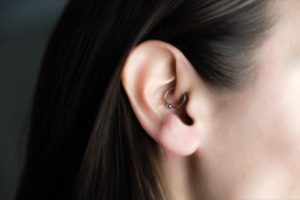Headache and Migraine

Description: a throbbing pain usually in one area of the head.
- Tension or stress headaches often start in the neck, moving up over the head to end up across the forehead and behind the eyes.
- In a migraine, feelings of being unwell build up to severe pain which can be accompanied by nausea and vomiting and sensitivity to light and sound, leading finally to exhaustion.
- Some people suffer from cluster headaches, with recurrent headaches in a predictable pattern.
- Headaches caused by dehydration or low blood sugar.
- Many women suffer from hormonal headaches, linked to the menstrual cycle, pregnancy or menopause.
If you are worried that your headache is different to usual, see the NHS advice here.
Tips: dealing with headaches
Mustard
Try eating a teaspoon of mustard powder or wasabi paste to help with the pain of a bad headache or a migraine. Other ideas for how to use mustard to help with headaches are to sniff hot mustard powder, or have a foot bath with mustard mixed into a basin of warm water. But do note that for some people mustard can be a migraine trigger.
Sunglasses
Tinted lenses can help to stop a migraine, if it is made worse by bright lights. Studies have shown that green light can reduce the pain of a migraine, but unfortunately scientists have not yet developed sunglasses that block all but green light.
Yoga
Some yoga poses can help with headaches. Poses that elevate your legs are particularly good. Try lying on your back on the floor and shuffle up your bottom against a wall, raising your legs so that they lean against the wall and your body is at a right angle. Or, lie on the floor and shuffle your bottom up to a sofa, raising your legs so that your calves are lying on the sofa cushions.
Acupuncture
Why note try acupuncture or acupressure if you don’t like needles? NICE recommends acupuncture for migraine and chronic tension headaches., and a trial published in the BMJ has shown that acupuncture can lead to 2.1 fewer migraine days per month.
If you don’t like needles, why not try acupressure instead? Amazon sells an Aculief clip to place in fleshy area between your thumb and first finger, as this is a headache acupressure point.
Other acupressure points for headache are:
- where the bridge of your nose meets your eyebrows – apply firm pressure here with your fingers for 10 seconds for headaches caused by blocked sinuses or eye strain
- between your eyebrows – press here firmly with your finger for 1 minute, again for headaches caused by blocked sinuses or eye strain
- the midpoint between the back of your neck and the tips of your shoulders – use your fingers to do a circular massage on 1 side for 1 minute, then do the same on the other side. This is good for tension headaches.
There is another headache acupressure point in your ear, and some people have claimed that having a daith piercing can therefore help prevent migraines:

There is no research to back this up, though. The American Migraine Foundation advises against daith piercings, as they can lead to infection, and any improvement in symptoms is probably due to the placebo effect.
Heat
If all else fails, try simple traditional remedies like placing a cold flannel on your forehead or a warm flannel on the back of your neck.
Tips: preventing headaches
Drinks
Make sure you drink enough water, as dehydration can be a cause of headaches. Caffeine and alcohol can trigger headaches in some people, so try to cut down on those.
Hemiplegic migraine
The initial symptoms of a hemiplegic migraine can be scarily similar to a stroke, and may last several days. This sort of migraine is more common in women aged over 50. If you have had a hemiplegic migraine diagnosed, it might be because of the wine that you have been drinking. The sulphites in wine have been particularly linked to hemiplegic migraines. If you can’t bear to cut back on the wine, you could try Sulfree. This is billed as a natural product that turns the harmful sulphites in wine into harmless sulphates. Just add a drop to your glass of wine.
Diet
Some foods can help to protect your body against headaches and migraines. Try to eat more foods that are high in magnesium, folate, potassium B vitamins and omega 3 fatty acids. Salmon, kidney beans, oats, spinach, cashew nuts, eggs, sunflower and pumpkin seeds and figs are all good choices. Some people are sensitive to MSG as a headache trigger, so check the ingredients on packaging, and be careful if eating out.
Meditation
A small trial in 2014 suggested that meditation may help to reduce the duration of migraines. Due to the size of the trial, the evidence is not strong, but if you are interested in trying it, our introductions to mindfulness are here.
Cannabidiol
Cannabidiol is a component of marijuana, but does not cause a high. It has been claimed to have a wide-range of health benefits, but there is little scientific evidence to back them up. One of the health benefits claimed is that it can improve headaches and migraine. If you fancy trying it out, you can currently buy CBD+ Oil from Holland & Barrett in the UK.
Improve your posture
Poor posture, for example slouching at a keyboard, can lead to tension headaches. If you spend a lot of time at the keyboard, try setting electronic reminders to check your posture. When your reminder pings, make an effort to lengthen your spine, imagining you are being pulled up to the ceiling by a piece of string.
Sleep, stress and anxiety
Poor sleeping habits and stress are also causes of headaches. Click here for our tips for a good nights sleep and reducing stress. People who suffer from migraines may also suffer from anxiety, and panic attacks can make migraines worse. Try out our tips for anxiety here. The American Migraine Association website also has help here.
Avoid painkillers
Try to avoid taking painkillers for headaches as much as you can, as overuse of painkillers to stop headaches has been linked to getting more headaches. If you think this might be behind your headaches, you’ll need to go cold turkey for up to a month to settle the problem. If you do have to take a painkiller, try an ibuprofen rather than paracetamol or aspirin, as ibuprofens are thought to be the least likely to trigger medication-induced headaches.
Eye strain
When was the last time you got your eyesight checked? If it’s been a while, try booking a test today, as eye strain is another cause of headaches.
Self-Care
Find the NHS Self-Care factsheet here.
